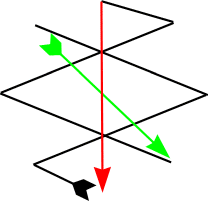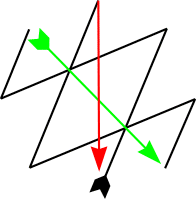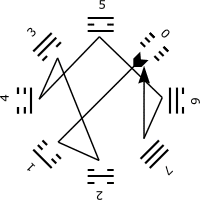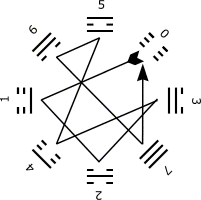

(This page continues from Luo Shu Origins - part 1.)
Every decent book on Feng Shui has a picture of the Luo Shu, but none that I have seen even mention that there are actually eight possible solutions to this magic square. Why, I asked myself, did the ancient sages choose this particular version to be handed down to posterity, and not one of the others?
When this mathematical puzzle was first dreamed up (see Luo Shu for details) it would have been immediately apparent that there was a correlation between it and the ancient Chinese field / settlement system of land division known as Jing (which is also a 3 x 3 square). This must have excited considerable interest among the anceint sages, and would have been enough to guarantee sustained investigation into its symbolic and allegorical ramifications.
The eight versions of this magic square can be compared at the One of Eight page. There, you can see at a glance that all eight versions produce a glyph that some simple transformations can map onto the Ba Gua glyph. So the shape of the glyph does explain why the Luo Shu version was favoured.
The solution is simply the direction of the lines.
By adding some arrowheads to the lines (to show the numerical sequence) we can readily see why the Luo Shu was honoured and the rest were forgotten. Start tracing the line at the black "flights" of the arrow, at the bottom.


Only the Luo Shu version combines two crucial features.
1) the lowest number, where the glyph begins, is at the bottom; and the highest number is at the top (these two extremes are linked here by the vertical red line that completes the glyph)
2) the centre of the glyph is crossed by a line that passes diagonally from top left to bottom right (shown here in green).
The top, bottom, and centre are the three levels of existence that are so fundamental to all Chinese philosophy: they are heaven, earth, and ourselves; they are the three layers of the Gua.
None of the other seven variants of the magic square match the Early Heaven Ba Gua's glyph in defining those three vital points.
The cross in the middle of each of these mystical glyphs is like the X that marks the spot on a treasure map: it shows the location of the throne of wisdom and, if you will, the abode of soul. Perhaps these traditionally sacred images might also reveal the route by which we may approach and explore these mysteries.
Incidentally, because the Later Heaven Ba Gua lacks any innate symmetry in its binary sequence, it does not map convincingly onto any of the eight magic squares.


Now that we have established the link between the Early Heaven Ba Gua and the Luo Shu, we may stand back for a moment and re-address the question: which came first?
I think the answer if fairly clear. The Early Heaven Ba Gua is based on observations of nature that are fundamental and simple (for an example see the lunar mysteries). The Luo Shu, on the other hand, is a mathematical puzzle that is artificial, sophisticated and refined. It seems entirely reasonable to suppose that the Luo Shu appeared as I have suggested, in emulation of its forbear, the Early Heaven Ba Gua.
© Ken Taylor 2004-2006